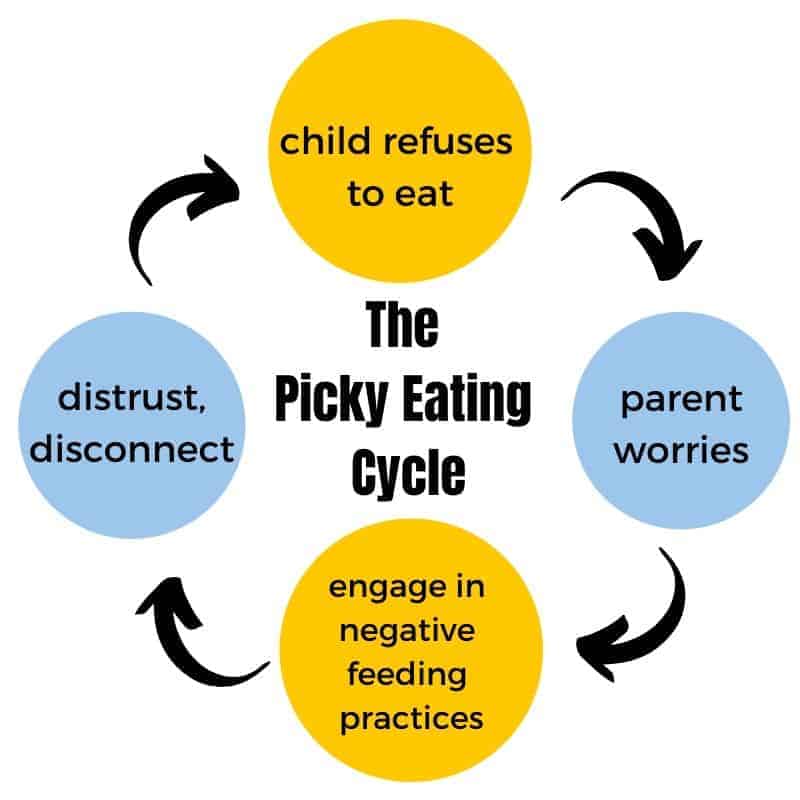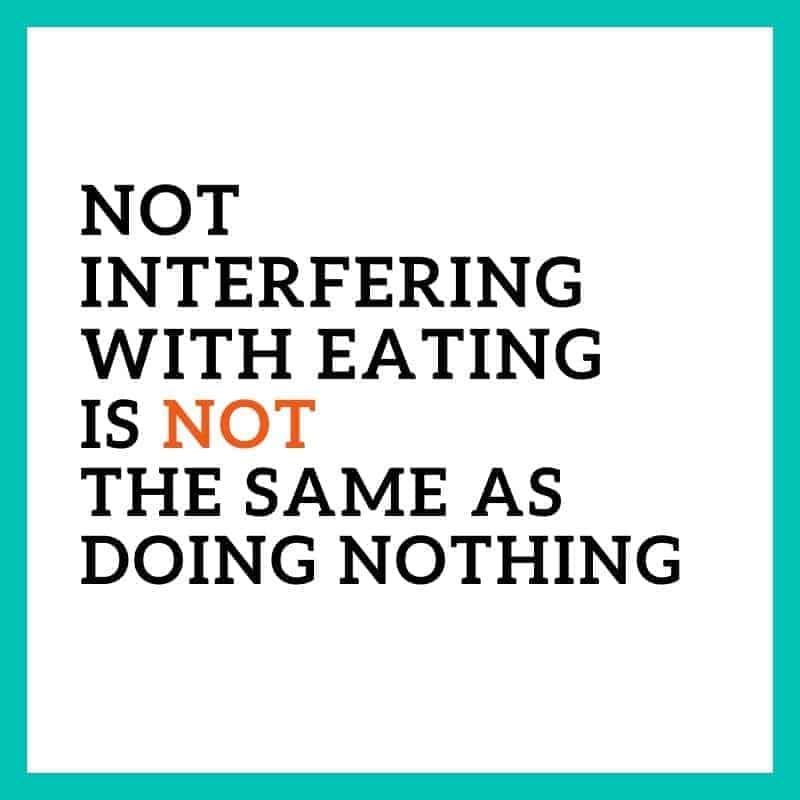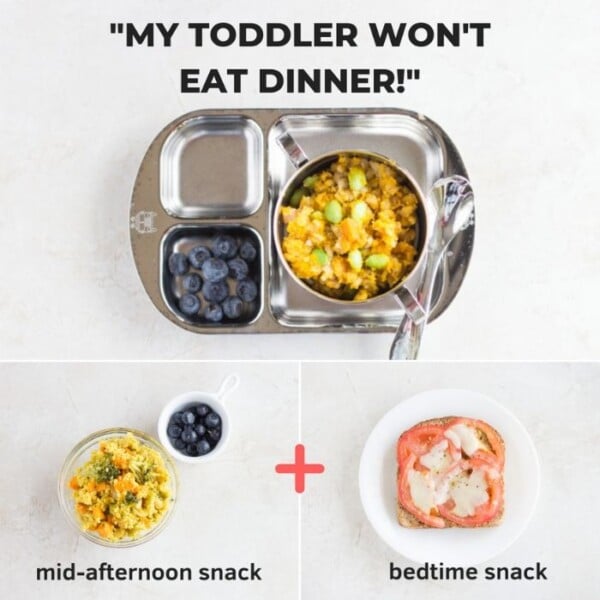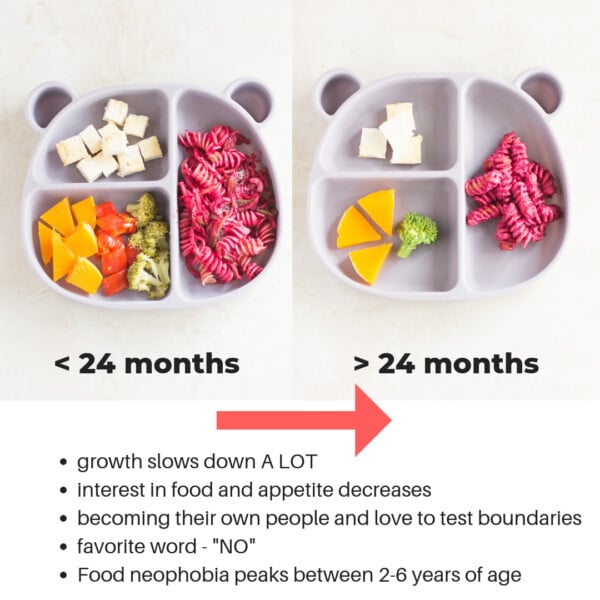This post may contain affiliate links. Please see our disclosure policy for more details.
It’s dinner time, and the same ole scenario is unfolding. You put food on the table and your toddler won’t eat! Not even one tiny little bite. At that moment, you just want to explode and before you know it, you find yourself doing what you always do – perhaps begging your child to take a bite, bribing them with treats, making them a special meal, etc.
If you find yourself dreading mealtimes, I’m here to tell you that they don’t have to a battle. There is a different way! There is! A positive and effective way that will not only save your sanity but also your relationship with your child and family mealtimes.
Why your toddler won’t eat?
First check out this post for top reasons why your toddler may be refusing to eat.
Allow me to paint a scenario: your child refuses to eat (again) –> you do what you always do – pressure, yell –> your child still doesn’t eat –> the meal ends horribly for everyone –> repeats again at the next meal and the next with greater intensity.

Change Begins with YOU!
I’m sure you are aware of Albert Einstein’s definition of insanity – Doing the same thing over and over again and expecting different results. Obviously, we’re not doing this on purpose, but as humans, we fall into this trap because we are creatures of routine and habit. After a while, our approaches become our security blankets, and it’s soo darn hard to try something different.
However, we must make a conscious effort to snap out of our comfort zone if we want different results than what we’re getting.
Unless We, the parents, change first, nothing will change. We must learn how to do things differently in order to help change our children’s behavior.
Here are the steps to consider:
- Think about what behaviors you want to see change
- How do you respond when these behaviors occur
- Recognize at least one reaction that you know doesn’t help make the situation better
- What action or response will you replace your reaction with moving forward
- Find an accountability partner – habits are hard to break so find someone to hold you to your new goal(s). A family member will be most ideal as they are present during mealtimes to keep you in check.
Here’s one example:
- I want my child to eat something, anything on the plate!
- I get soo angry and frustrated that I end up yelling and pressuring them to take a bite
- When I yell, it seems like my child retaliates more to get a rise out of me
- I’m going to try to remain calm and not force my child because I now know the importance of creating a positive mealtime atmosphere. That means I’m going to serve the meal (making sure there’s at least one thing on the plate my child likes), enjoy my meal at the table, and if they don’t eat it, then I will simply end the meal.
- I’m going to ask my husband to hold my hand or give me a stare when it looks like I’m going to lose my cool.
Now, I want to point out that change takes time. It’s not going to happen overnight. But stay the course. Remember, you, the parent, are the catalyst for change.
Pressuring simply doesn’t work
I wrote a whole blog post on all the different forms of pressure and how they can negatively impact your child’s eating experiences and preferences. This is really important to address as these effects can last a lifetime.
What to do instead?

First, get past the fear. The fear of giving up control. The fear that if you stop doing (making special foods, pressuring to take a bite, etc.) they won’t eat! The fear that if you let them decide, they may only eat bread or they will always go hungry; that they won’t get the nutrients they need.
Ironically, the harder you work to try to get your child to eat, the less likely your child will eat. Instead of focusing all your efforts on getting your child to eat, which is not your job, focus on the things that are ARE your responsibility and that you do have control over.
-
Choose what, when, and where the meals will be served – a.k.a the division of responsibility in feeding
-
Serve and expose your child to a variety of nutritious foods.
-
Be considerate of their preferences and limitations.
-
Create a happy, safe eating environment. Make the table a place that exudes positivity, encourages curiosity, not a place to be feared.
-
Be decisive and reliable (setting mealtime structure and limits and following through consistently) while at the same time, be respectful and tuned in with our children (letting them take full control of what and how much, if any, they are hungry for).
-
Role model. Their curious little eyes are always watching. Kinda sweet and scary at the same time, no? hehe.
To Sum:
Change is hard. So hard. BUT if you change what you do and keep it changed, your child will change right along with you. I learned during our recent trip to Korea just how resilient and adaptable my toddler is! They truly are amazing little human beings, aren’t they? And oh how we love them so!
Let’s help our children learn to become joyous, mindful eaters by avoiding the urge to pressure or intervene with their job, which is deciding what, how much, and whether or not they will eat. Instead, let’s focus on our role in feeding.
Write down the list above and place it somewhere in your kitchen, dining room, or wherever you’re most likely to see it.
And do whatever you need to do before mealtimes to keep your emotions in check. Allow the table to be a place of happiness, safety, warmth, and one that encourages curiosity. THAT truly is the secret sauce in helping your child learn to enjoy food and family mealtimes















Absolutely love this. I sent it to my husband. people are always saying your child is so small he doesn’t eat enough, is he picky, he is not picky at all. So love this it should be a book!!
Can be so hard when you hear comments like that! So frustrating, isn’t it? You’re an amazing mama!
Hi Min! Great post. Does role modeling mean you need to eat exactly what you’re feeding your toddler?
Hi! That will certainly help especially with foods your toddler is learning to like. But you don’t always have to eat the same because we, mamas, gotta honor our cravings too 😉
Love this post! Thank you so for giving me confidence to have successful meals with my toddlers.
I’m so glad!! You got this!! 😉